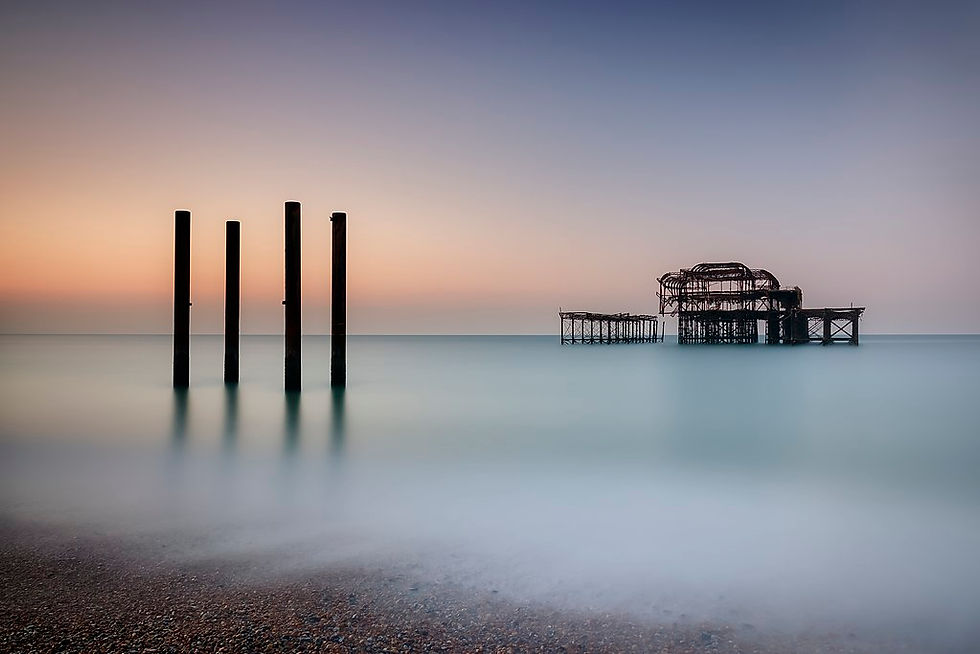Writers in Sussex: Patrick Hamilton and the Shadows of Brighton
- Ellen Cheshire
- Oct 10
- 3 min read

Patrick Hamilton’s The West Pier (1952) captures a very different side of Sussex from the pastoral warmth of Kipling or the wistful nostalgia of Belloc. His Brighton is a place of illusions, its arcades and promenades concealing moral decay and human weakness. The novel opens beneath the shadow of the West Pier, a structure that, in Hamilton’s imagination, thrums with life. Today, little of the old West Pier remains - its elegant ironwork now just a ghostly silhouette against the sea. Yet in Hamilton’s pages it endures, alive with the hum of slot machines, the smell of salt and fried fish and the uneasy laughter of a crowd that suspects, even as it smiles, that the lights will soon go out.

Written in the early years of post-war Britain, The West Pier introduces one of the most unsettling figures in modern fiction, Ernest Ralph Gorse, a charming sociopath who preys on the innocent and the lonely with polite precision. In Gorse, Hamilton created a figure both monstrous and mundane, a man whose evil is disturbingly ordinary, who charms simply by noticing what others overlook.
“He was a tall, fair man, good-looking in a rather obvious way, with that air of easy self-possession which is always so attractive to the inexperienced... Esther had met kind men, clever men, even handsome men, but none, she thought, so thoughtful as this. And yet, behind his attentiveness, there was something faintly chilling, a blankness in the eyes when they were not smiling, a quickness of calculation when he thought himself unobserved.” - The West Pier (1952)
Hamilton was born in Hassocks in 1904 and educated in Hove. Long before he wrote The West Pier he had explored moral entrapment and psychological cruelty in Rope and Gas Light, both adapted into major films. But it was in The West Pier that he found the perfect stage for his vision of quiet corruption: the seafront itself, where light and shadow meet, and where everyone is on display, performing their own small deceits.
Brighton, for Hamilton, is less a resort than a moral landscape, a place where the respectable and the desperate mingle, where the glint of amusement hides exhaustion and loss. As he wrote:
“Brighton was full of people who had come down to enjoy themselves, but the curious thing was that nobody seemed really to be enjoying themselves at all.” - The West Pier (1952)
That single observation captures Hamilton’s entire moral universe. Behind the cheerful façades and fairground promises lies fatigue, falseness and a peculiarly English sadness. His Brighton is a city of pretence and performance, its charm fading at the edges, as haunted in its way as Graham Greene’s Brighton Rock, where another young man’s corruption plays out against the same uneasy sea light.

Later writers would find new stories in this same landscape of shifting light and shadow. In The Brighton Mysteries series by Elly Griffiths (2014 - 2023), beginning with The Zig Zag Girl set in 1950 and running through to The Great Deceiver in 1966, post-war Brighton becomes a stage once again, not just for crime and illusion but for memory, resilience and reinvention. Griffiths’ Brighton still flickers with ghosts, but its darkness has heart and history as well as menace.
Hamilton’s Sussex is the dark inverse of Kipling’s beloved Downs, a place of erosion rather than endurance. Yet it too is recognisably, vividly Sussex: the same light, the same restless sea, but turned towards the human shadows it throws.

This entry continues our series on Writers in Sussex, exploring how the county’s landscapes have inspired visions both radiant and unsettling.



Comments